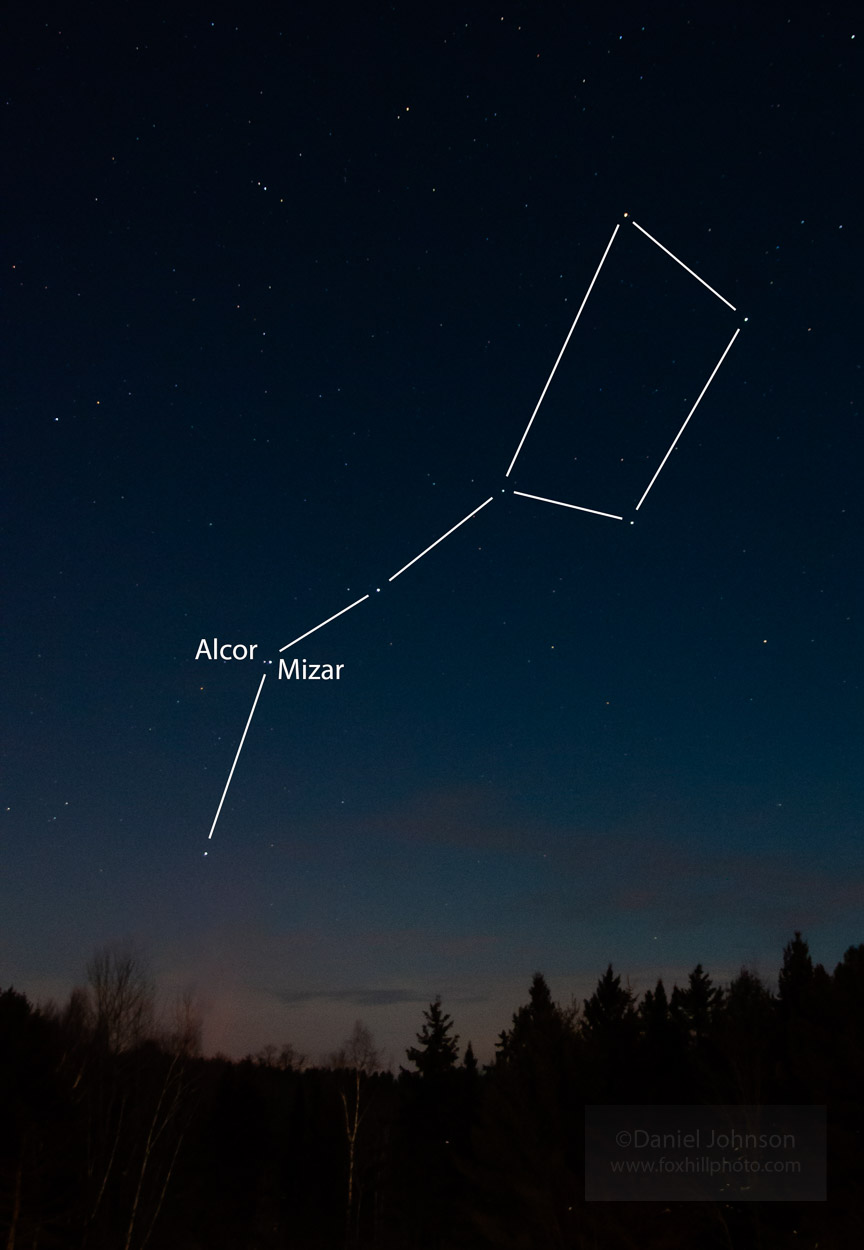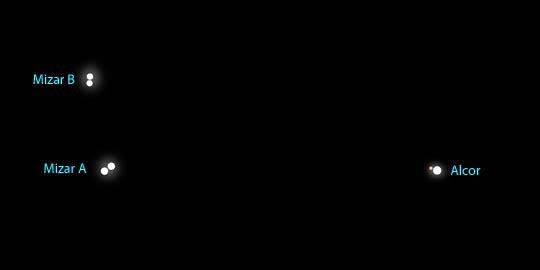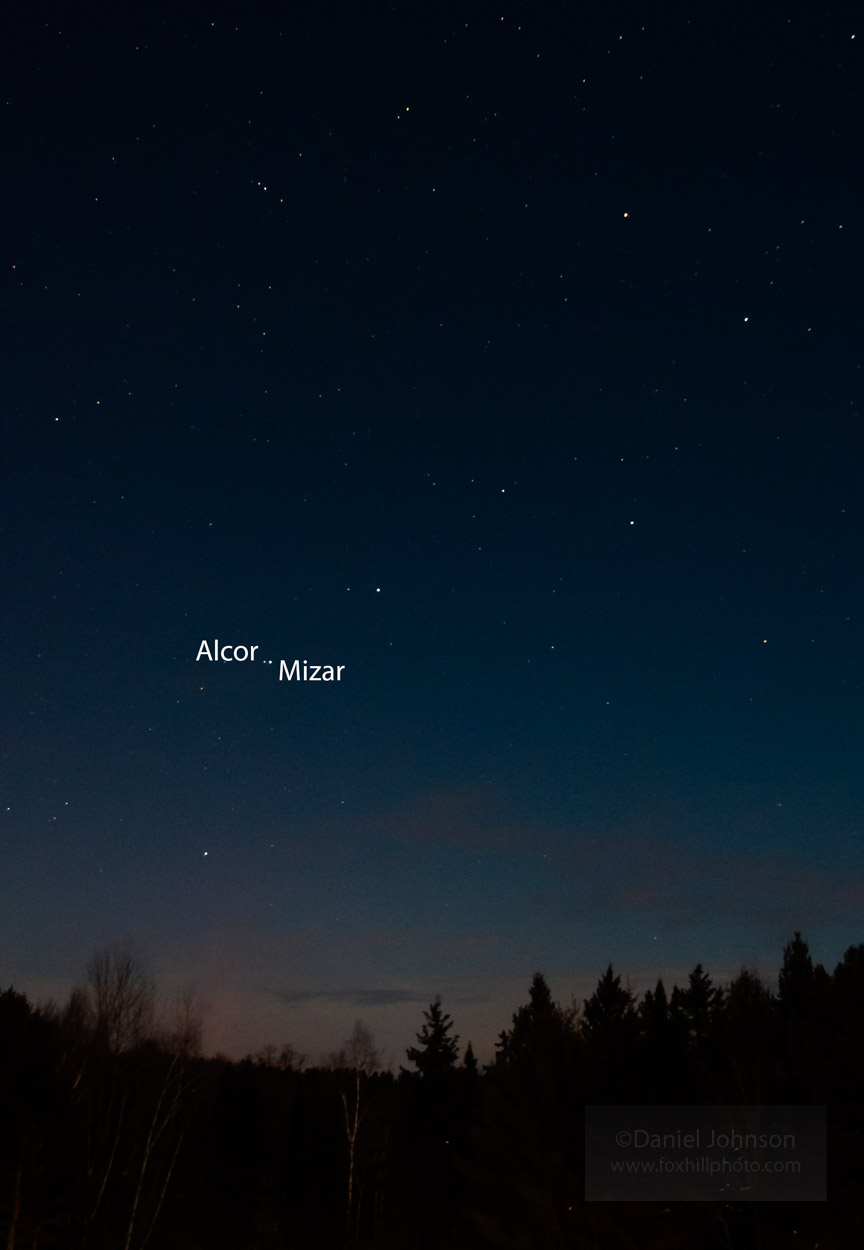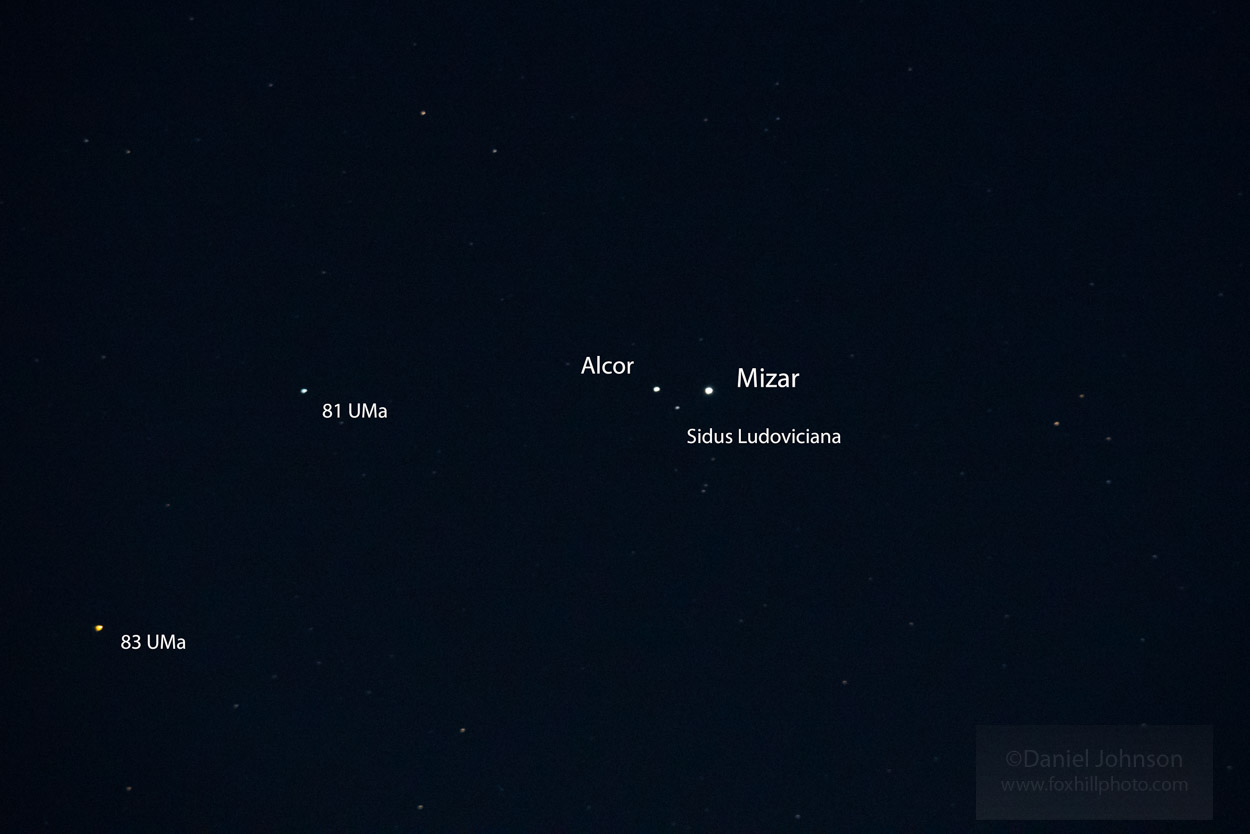Mizar and Alcor, stars sometimes referred to as “the horse and the rider,” serve as a vision test and an introduction to “double stars.”
Mizar & Alcor: The Vitals
| Official name | Mizar | Alcor |
| Other designations | Zeta Ursae Majoris, HIP 65378, HR 5054, HD 116656 | g Ursae Majoris, HIP 65477, HR 5062, HD 116842 |
| Nickname (pair) | ||
| Nicknames (individual) | - | Jack on the Middle Horse |
| Apparent magnitude | 2.2 | 4.01 |
| Distance from Earth | 85.8 light-years | 81.5 light-years |
| Spectral type | A2V | A5V |
| Color | ||
| Mass | 2.2 M☉ | 1.8 M☉ |
| Radius | 2.4 R☉ | 1.9 R☉ |
| Constellation | ||
| Right ascension | 13h 23m 55s | 13h 25m 14s |
| Declination | +54° 55' 31" | +54° 59' 17" |
| Multiple system? | Yes | Yes |
| Variable star? | No | No |
| Exoplanet status | None known | None known |
| Probable fate | ||
Physical Characteristics
Binoculars and telescopes can open up new worlds for beginner stargazers who are ready to take a step beyond their own eyes in astronomy. One enjoyable pursuit is to search for double stars — stellar companions that initially appear to be a single point until optical aid reveals a close but distinctly separated pair. This technique is often called splitting a double star.
But hold off on the binoculars for a moment. There’s one famous double star that you might be able to split with your eyes alone: Mizar and Alcor, of the Big Dipper asterism in Ursa Major. The pair represents the middle star of the Dipper’s three-star handle. After a moment or two of careful looking, especially under dark skies, many people are able to see two distinct stars, with a faint star (Alcor) just a short distance from the much brighter Mizar.

Daniel Johnson
This association brings up a question: Are Mizar and Alcor a true binary pair, with the double stars physically close and sharing a gravitational field? Or is the situation merely a line-of-sight effect, with the two stars appearing close together but in reality separated by a vast distance?
Line-of-sight pairings happen all the time in astronomy, but in the case of Mizar and Alcor, it seems that the pair really is a true binary. Even though Mizar and Alcor are more than 80 light-years away, observations suggest that Alcor is traveling around Mizar in a long orbit that takes 750,000 years to complete. Mizar and Alcor travel through space in tandem, loosely tied together by their own gravitational fields. They’re also part of the Ursa Major Moving Group, which includes many of the Big Dipper stars (with the significant exception of renegade Dubhe).
But there’s even more going on in these systems than is visible at first glance. Mizar actually has another companion called Mizar B, which is much, much closer to it than Alcor is. It’s possible to spot Mizar B with a telescope, but it’s a tricky find and much more challenging than spotting Alcor. What’s more, Mizar A, Mizar B, and Alcor are each also paired by a spectroscopic binary — for a grand total of six individual stars. These final three companions are not visible with ordinary gear and require a spectroscope for detection.

Bob King
Most of the stars in the Alcor-Mizar system system are on the main sequence, A-type stars in the prime-of-their-lives that are fusing hydrogen in their cores. The lone exception is Alcor’s little companion, a red dwarf star like our nearby Proxima Centauri.
| Mizar | Alcor |
| Mizar A (star seen without optical aid) | Alcor A (star seen without optical aid) |
| Mizar B (visual companion, telescope needed) | Alcor B, A’s spectroscopic companion |
| Mizar A’s spectroscopic companion | |
| Mizar B’s spectroscopic companion |
We’re so used to living near the Sun — a solitary star without any nearby companions — that it can be fun to learn just how many double- and multi-star systems there really are in our galaxy.
Origin / Mythology
Mizar and Alcor are sometimes known as the “Horse and Rider,” with the brighter Mizar representing the horse and the dimmer Alcor acting as the “rider” on its back. It’s a fine analogy and a nice mental image that goes back to ancient Arabic astronomers, who also regarded the ability to see the fainter Alcor as a test for good vision. Interestingly, the modern name for Alcor derives from the Arabic for “Black Horse,” although this would seem to suggest that perhaps Mizar is the rider. But ancient Arabic astronomers called the star the “overlooked one.”
But the connection of the Mizar-Alcor pair with horses goes further. While the Big Dipper is commonly visualized as a spoon or ladle in the U.S., one tradition in the UK instead imagines the Dipper as a horse-drawn wagon, with Mizar representing one of the horses or perhaps a horse’s back. In this case, Alcor is sometimes called “Jack on the Middle Horse.”
Horses appear fairly frequently in sky-related mythology — no surprise, considering the animal’s long impact on humanity. Besides the nicknames for Alcor and Mizar, there is also the Pegasus constellation, a smaller constellation called Equuleus, the foal, Monoceros, the Unicorn, and a dark patch in the Milky Way, called the Dark Horse Nebula. And of course there is the famous Horsehead Nebula.
Due to Mizar and Alcor’s brightness and location on the sky, they’re featured in many other stories. In one myth from the Iroquois of eastern North America, several hunters, represented by birds (including Mizar, the chickadee) pursue a bear (seen as the four stars of the Dipper’s bowl). Mizar brings with him Alcor, a cooking pot — another nice mental image!
In the fall, one of the hunters injures the bear, which stands up on its hind legs (as the Big Dipper appears tilted in the evenings) and shakes blood over the leaves of the forest, turning them red. The hunters eat the bear, leaving its skeleton to lie on its back through the winter months, before the bear rises again and the hunt begins anew.
How to See Mizar and Alcor

Daniel Johnson
The Big Dipper won’t need much of an introduction for most folks, but if you’re very new to astronomy and aren’t sure, just look north on a clear night and the Dipper is easy to find. A simple star chart will show you the Dipper’s position more specifically. It’s visible for at least some portion of the night throughout much of North America, though depending on the season and the time, the Dipper might be on its side or even upside down.
Mizar and Alcor form the center star of the Dipper’s handle. After trying to find Alcor with your eyes only, go ahead and get out a pair of binoculars for easier viewing. Alcor should now easily pop. Photos can give you a good idea of what you’re looking for in regards to the relationship in brightness and distance between the two stars, although their exact orientation depends on where the Big Dipper is.

Daniel Johnson
Next, move up a notch and fetch your telescope if you have one, and take a closer look at Mizar in particular. Can you spot its other companion, Mizar B? One word of caution: watch out for Sidus Ludoviciana! This is a fainter, 8th-magnitude star situated between Mizar and Alcor, but it’s not part of the system — it’s much farther out and is just a background star.
While you’re in this region of the sky, you can also try searching for the nearby — and famous — Pinwheel Galaxy. Using a star chart of the area, see if you can find the 4th-magnitude star 83 Ursae Majoris (83 Uma), which has a definite orange color. Draw an imaginary line between Mizar-Alcor and 83 Uma and then use that line to point your way towards the Pinwheel. While this galaxy is much larger than our Milky Way, the general shape is likely similar, so you’ll get a nice view of how the Milky Way might appear if you could look “down” on it.
As for double stars, you could make a hobby out of finding and splitting the multitude of examples in the sky. Use Mizar and Alcor (and Mizar B!) as a confidence builder to introduce yourself to the fun and challenge of splitting stars, and you won’t run out of potential targets any time soon. Once you get good at it (and perhaps with the help of a large telescope), why not try a super challenge — splitting Sirius A and B. Not easy!
That’s part of the fun of astronomy — there’s something to try at every skill level. If you’re just starting out, you can’t top Mizar and Alcor for an early target.
Daniel Johnson is a Wisconsin-based freelance writer and professional photographer and the coauthor of more than a dozen books. He’s a longtime amateur astronomer and fortunate enough to live in a rural region with excellent seeing conditions. You can view some of Dan’s photography (he does a lot of animals!) at foxhillphoto.com
 0
0








Comments
You must be logged in to post a comment.